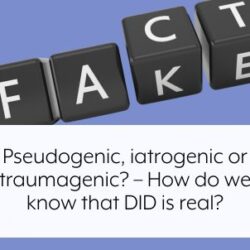
Being diagnosed as having a dissociative disorder is by no means straightforward. The ISSTD Guidelines for Treating DID in Adults (2011) give four reasons for these difficulties:
- There is a lack of education amongst clinicians about dissociation, dissociative disorders and trauma.
- Most clinicians wrongly believe that dissociative identity disorder is ‘a rare disorder, with a florid, dramatic presentation’ (p.117).
- The standard diagnostic tools and mental status examinations that most clinicians have been taught to use during professional training do not include questions about dissociation, post-traumatic symptoms or a history of trauma.
- Having received little or no training in dissociative disorders, many clinicians have difficulty recognising the signs and symptoms.
Diagnosis versus misdiagnosis
The ISSTD assert that assessment for dissociation should be part of every diagnostic interview, given that dissociative disorders are ‘at least as common, if not more common, than many other psychiatric disorders that are routinely considered in psychiatric evaluations’ (p.124). A number of diagnostic tools have become available in recent years to assist with screening and diagnosis of dissociative disorders, and a summary of the most well-known of these can be found here. The ‘gold standard’ is generally considered to be the SCID-D-R developed by Marlene Steinberg (1994), which is due to be updated to bring it in line with the latest DSM-5 diagnostic criteria.
Diagnosis of dissociative identity disorder is generally dependent on the criteria in the DSM-5 (Diagnostic and Statistical Manual, fifth edition) which is published by the American Psychological Association and mainly used in the United States and Canada. In the UK and other parts of Europe, the ICD-10 (International Classification of Diseases, tenth edition) is more often used, which still talks only about ‘Multiple Personality Disorder’.
Both view manuals view dissociative disorders somewhat differently. The DSM understands dissociative disorders as being chronic, long-term conditions that are developmental in nature – in other words, they develop over a period of time in response to trauma and attachment difficulties as a child’s brain grows and matures, and they therefore tend to persist over time too as they are more or less ‘hard-wired’ adaptations. The ICD, however, sees dissociative disorders as being on the whole acute (i.e. short-term), reactive, and transient responses to here-and-now traumatic experiences. Both concepts are part of the truth, an issue acknowledged by the DSM taskforce, and there are attempts underway to merge the conceptualisations of DDs for the next update to the ICD.
Prior to the updated DSM-5 criteria, diagnosis was largely dependent on the clinician observing a switch between two distinct identity states. Paul Dell (Dell & O’Neil, 2009) amongst others argued convincingly that switching was a fairly infrequent symptom of dissociative identity disorder, and only occurred in 15% of diagnostic interviews. The new criteria now allow for discontinuities in sense of self and agency to be self-reported.
Why is a correct diagnosis difficult to achieve?
Dissociative identity disorder is often misdiagnosed and research suggests that people with DID usually spend between 5 and 12 years in the mental health system before receiving a correct diagnosis (ISSTD, 2011). Part of the reason for this is that people with DID often present to mental health professionals with a range of symptoms, with the specifically dissociative and post-traumatic ones often obscured by a complex mix of depression, panic, somatoform symptoms and eating disorders. Usual misdiagnoses include schizophrenia, schizo-affective disorder, bipolar disorder, borderline personality disorder, epilepsy or pseudo-seizures, eating disorders, and alcohol or drug addiction. The mean age at correct diagnosis is between 28 and 35 years (Putnam, 1989).
In the UK, getting a diagnosis for dissociative identity disorder can be extremely difficult. Many psychiatric teams do not accept the existence of the diagnosis, having been taught that it is controversial and not supported by research. Although this is patently not true, it can often be difficult to shift this mindset, and a diagnosis of borderline personality disorder or complex post traumatic stress disorder may often be the outcome in these circumstances. There are a number of individuals and organisations who provide private services and diagnostic testing for dissociative disorders – in the first instance check with The Pottergate Centre (www.dissociation.co.uk).
Diagnosis of dissociative identity disorder – advantages and disadvantages
There are both advantages and disadvantages to receiving a diagnosis of dissociative identity disorder. The greatest benefit is receiving appropriate, publically-funded treatment (i.e. in the UK, via the NHS), although this happens only occasionally. It can also be both helpful and reassuring to be able to put a ‘name’ to the group of symptoms that represent DID. This can guide both the patient’s own drive for understanding and acceptance, and can inform the course of therapy. As shame is one of the most debilitating aspects of a dissociative disorder, being able to connect with others with the same diagnosis can help to break that shame and the overwhelming isolation that often goes with it.


